3. The Risk Factors: Who’s in the Shingles Hot Seat?

Shingles doesn’t play favorites, but certain factors can make an individual more susceptible to this condition. Age, for one, is a significant player. While young adults can and do get shingles, the risk markedly increases as one crosses the 50-year threshold. The reasons? As we age, our immune system naturally becomes less robust, making it easier for the dormant virus to wake up.
Stress, both physical and emotional, can also be a trigger. Chronic stress, in particular, takes a toll on our immune defenses, providing the virus with an opportunity to resurface. Similarly, individuals with weakened immune systems, whether due to diseases like HIV or treatments like chemotherapy, are at an elevated risk.
Interestingly, genetics might play a role too. Some studies suggest that if a close family member, like a parent or sibling, has had shingles, your risk might be slightly higher. It’s a reminder that while we can control some risk factors, others are woven into our DNA.
Yet, it’s essential to remember that while these factors increase susceptibility, they don’t guarantee a shingles outbreak. They simply raise the odds. The unpredictability of shingles remains one of its most vexing characteristics. (3)